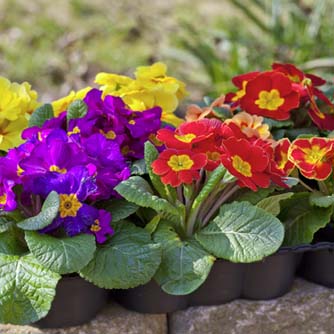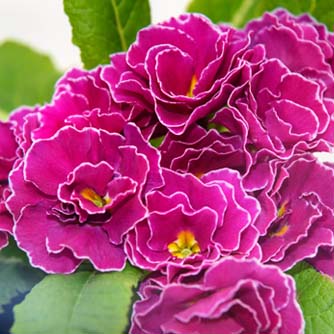Polyanthus
BackPolyanthus are a type of primula (Primula x polyantha) which produces incredibly bright cheerful flowers from July through to October. Technically a perennial they are grown as annuals across Australia except in the colder regions. Either way with their crinkled leaves and bold flowers they are unbeatable at brightening up a lacklustre winter garden.
How To Grow Polyanthus
Polyanthus are usually purchased as seedlings or potted colour anytime from autumn through to winter. If you are a keen gardener you can sow seed but this is trickier because the seed is very small and germination can be a bit hit and miss.
Polyanthus are happiest growing in conditions which get bright shade or gentle sunlight so they don’t heat up. They also like moist soil which is rich and fertile. Whilst they can tolerate less than ideal conditions if you really spoil them then you’ll get a better showing.
So with all that in mind choose your spot in the garden and prepare the soil with lots of compost and an organic pelletised fertiliser. If planting into pots or containers, use a good quality premium potting mix. Settle plants in using OCP eco-seaweed and mulch to maintain moisture and help protect from soil splash.

Brightly coloured polyanthus flowers
Sowing Guide for Polyanthus
| Growing Zone | Sowing Time |
| Cool Zones | Late Summer, mid Autumn |
| Mediterranean Zones | Late Summer, Autumn |
| Warm & Temperate Frost Free Zones | Late Summer, Autumn |
| Tropical & Subtropical Zones | Late Summer, Autumn |
For best results, sprinkle seed onto seed raising mix in punnets or small pots. Maintain a moist surface for 3-4 weeks until seedlings start to emerge. Apply OCP eco-seaweed to get them off to a great start.
Fertilising and Maintenance of Polyanthus
Polyanthus need regular watering so don’t be stingy with the watering. They should also be fed with OCP eco-seaweed and OCP eco-aminogro every two weeks to grow strong plants and encourage continuous flowering.
As with all annuals it is best to pinch out the first flowers of small seedlings to encourage stronger growth of the plant. Then it’s just a matter of regularly deadheading and pulling off any yellowing leaves to keep plants tidy and free from disease.
Once the warmer weather hits polyanthus will die down. In cool regions they’ll reappear each year but for most of Australia it’s too hot for them to survive and they’ll die off completely. Polyanthus also don’t do self-seed so they’ll need to be resown or planted again the following year.

Large polyanthus seedlings already in full flower
Pest and Diseases of Polyanthus
Polyanthus suffer from few pest and diseases as long as they have regular water and are kept fed with OCP eco-seaweed and OCP eco-aminogro. If anything is likely to occur it will be:
- Snails and slugs – these guys love polyanthus and you may find holes in the flowers and leaves. Use OCP eco-shield pellets to control these pests.
- Caterpillars – it’s the same with caterpillars as they love polyanthus too! Spray OCP eco-neem at the first sign of damage.
- Rotting – plants can develop rot when grown in incorrect conditions. Most likely it will be when the soil is too wet from poor drainage or if there isn’t good airflow around plants. Remove damaged flowers and foliage and try to improve the growing conditions. Fortnightly doses of OCP eco-seaweed and OCP eco-aminogro will help build up resilience to diseases while giving you lots of flowers.
- Powdery mildew - this common disease can be controlled with an organic fungicide but do spray quickly as the disease will spread.

The stunning double flowering polyanthus!


